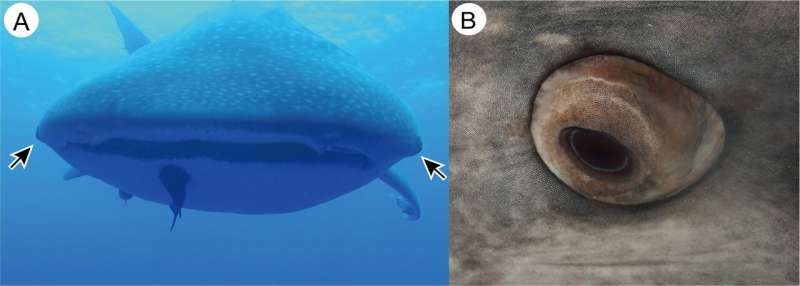Eyes of the whale shark. A. Anterior view of the whale shark, showing the locations of the eye (arrows). Note that whale shark eye is well projected from the orbit. Photo was taken in the sea near Saint Helena Island. B. Close-up view of the left eye of a captive whale shark (Specimen A). Credit: PLOS ONE (2020). DOI: 10.1371/journal.pone.0235342
A team of researchers working at Japan's Okinawa Churashima Research Center has found that whale sharks have thousands of dermal denticles (tiny teeth) in the skin surrounding their eyeballs. In their paper posted on the open access site PLOS ONE, the group describes their study of the teeth and suggest possible functions.
Whale sharks, as their name implies, are very large—they can grow to be 18 meters long. They are unique in other ways, as well—they tend to eat mostly plankton and they have eyes on the sides of their heads instead of in front, as is the case with most other sharks. They can also retract their eyes if need be to protect them from other creatures in the sea, and unlike most other sharks, they do not have eyelids. Now, researchers have found that their eye coverings are covered in tiny teeth.
As part of an effort to learn more about whale sharks, the researchers studied the eyes of both living and dead animals from aquariums and those washed up on shore. They discovered that the eye coverings are covered in dermal denticles. Whale sharks have protruding eyes contained in a casing that bulges out into the water, and on its tip is the visible part of the eye. The researchers found that the entire casing, except for the visible eye parts, is covered in dermal denticles with an oak-like shape that is similar to human molars.
Prior research had shown that whale sharks have dermal denticles on other parts of their body—in fact, on most of their body. The sharks have placoid scales, which are made of hard enamel and resemble teeth, unlike the scales of other animals. Such tiny teeth are not used for chewing, of course, they are used for protection. Their hardness makes it very difficult for other sharks to bite them. Also, the scales are arranged in a way that helps the shark swim faster.
The researchers found that each whale shark eye covering had approximately 3,000 denticles and that they were most densely packed near the iris. They suggest the denticles serve to protect the eyes from attacks by other sea creatures.
More information: Taketeru Tomita et al. Armored eyes of the whale shark, PLOS ONE (2020). DOI: 10.1371/journal.pone.0235342
Journal information: PLoS ONE
© 2020 Science X Network
























